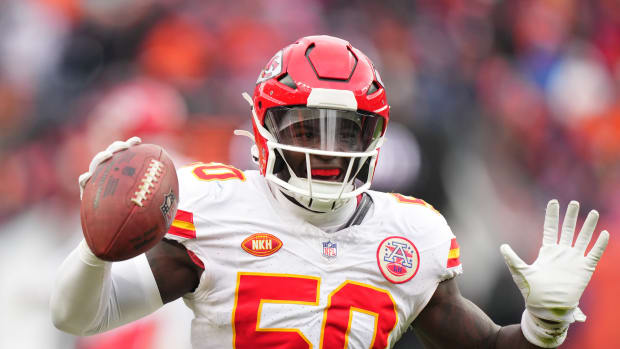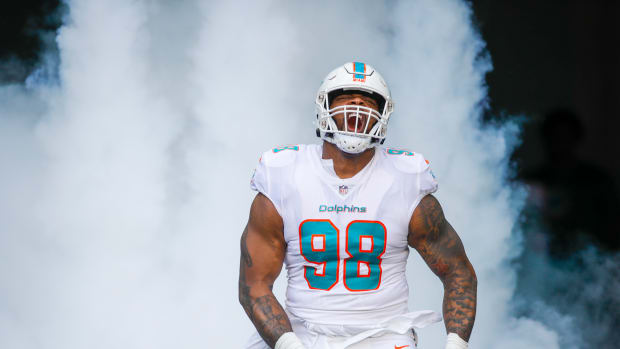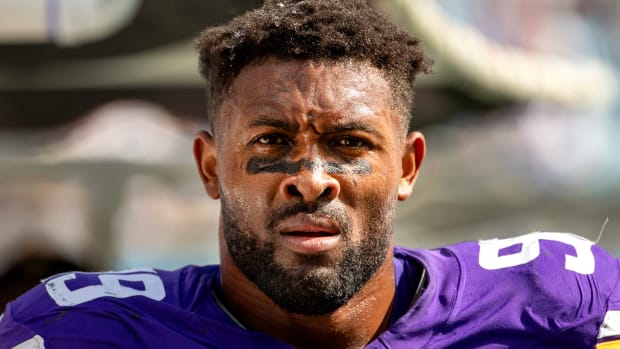The Learning Curve for Rookie Tight Ends
In the Super Bowl era, from 1967 until now, there have been 899 tight ends taken in the NFL draft (via DraftHistory.com). Of those 899, not one has reached the 900-yard receiving plateau as a rookie. Rob Gronkowski wrapped his first pro season with 546 yards; Greg Olsen with 391. Tony Gonzalez, named by NFL.com’s Gil Brandt as the greatest tight end of all time, had 368.
The last tight end to hit 900 yards: Mike Ditka, back in 1961, when he posted 1,076 yards—the only time in his career he topped the 1,000-yard mark.
Teams aren’t—or, at least until more recently, have not been—drafting tight ends to be instant-impact playmakers on offense, reserving those expectations instead for running backs and wide receivers. The overall lack of production from rookie TEs stands as a glaring bit of history for any NFL newcomer at that position.
Each case is different, but tight ends arriving in the league typically fall under one of two categories: They’re seen primarily as blockers, without the requisite athleticism or role within their new offense to produce big numbers; or they’re pass-catching threats who struggle to get on the field early, because they aren’t reliable enough when they do have to block.
Jordan Reed vs. the Laws of Physics
“It’s getting harder to find the guys that do both,” says Jon Robinson, the second-year GM of the Titans, who had the good fortune to inherit dynamic tight end Delanie Walker. But to the point here, Walker had two receptions as a rookie and just 31 over his next two years in the league. He did not bust out as the player we know now until a move from San Francisco to Tennessee ahead of the 2013 season.
“Delanie, when he was coming out, I remember scouting him,” Robinson says. “He was basically a receiver [at Central Missouri State], and that’s kind of how they used him in San Francisco, and he slowly improved as a blocker and got more catches. ... That position group, it’s a lot to learn. They have to know the run blocking, they have to know the pass protection, the routes. There’s just a lot of stuff on their plate that they have to know offensively.”
During February’s Super Bowl week in Houston, Cowboys tight end Jason Witten discussed this topic during an interview with SI.com. Long one of the best at his position, and a likely Hall of Famer, Witten turned in a 35-catch, 347-yard rookie season for Dallas. He said it took him almost half that 2003 campaign before he began “really hitting my stride.”
“I don’t know that it’s a learning curve, I think it’s just a hard position to play,” Witten said. “In this system in Dallas, until you can consistently block at the point of attack under [former head coach Bill] Parcells’s system, they weren’t going to put you in to go catch seam balls. I think guys are making the transition easier and easier year in and year out than it was 20 years ago, even 14 years ago for me. But I think that in college football, you can get on the perimeter and spread out, there’s a lot of check down, underneath stuff, and in pro football the coverage is tight.”
The blocking aspect is at the heart of this discussion. Robinson made mention of what a task it is these days to find a college tight end comfortable as both a receiver and a blocker, because many of the country’s premier draft prospects simply do not have to fill the latter role that often.
Take Chicago’s Adam Shaheen, for example. He set an Ashland (Ohio) University school record last season with 16 receiving touchdowns, also an NCAA D-II record for tight ends. He tested well at the combine, including 24 bench-press reps. He’s 6' 6", around 280 pounds, and has the coveted background as a former basketball player.
And until he attended the Bears’ rookie minicamp and then OTAs, he admits he “really had never pass-blocked.”
“The tight end position is just so dynamic,” Shaheen says, “being a part of the run game and pass game. You’ve got to be smart to play it, and I think, behind quarterback, it’s one of the toughest to learn and make that transition not only in the playbook but also in techniques.”
Coaching staffs have little recourse but to throw these guys into the fire. For Shaheen at a recent training-camp practice, that meant blocking Leonard Floyd during a passing drill.
Cleveland tight end Seth DeValve’s “welcome to the show” moment came from a blocking assignment during his NFL regular-season debut: “Brandon Graham, Phailadelphia Eagles, Game 1 last year. That was kind of an eye-opening experience.”
The line between tight ends and receivers continues to evaporate at a steady clip. DeValve actually was a wide receiver in college at Princeton, then shifted positions after the Browns drafted him with pick No. 138 last year. He caught 10 passes for 127 yards as a rookie.
“[Blocking] is the thing I’ve done the least,” DeValve says, after making two receptions in the Browns’ preseason opener. “Route-running I did in college, three-point stance blocking I didn’t do a whole lot of.”
Game Plan: Bengals Hit Reset Button With New Leadership Core
Think about what a huge gap that is in a player’s game as he enters the league. The reason teams invest so heavily (and/or foolishly, depending on which teams we’re talking about) in offensive tackles is that even the worst NFL defenses have freakish athletes off the edge. The Leonard Floyds and Von Millers and Vic Beasleys of the world can disrupt entire game plans single-handedly. Tight ends shouldn’t be responsible for stifling those players on their own, but they do have to help the cause.
The choice often facing coaches, then, is: Do we risk our pass protection, and our quarterback, by testing a tight end who’s not quite ready? Or do we ease that tight end into the lineup, and hope that slowing down the process produces results down the road?
In the majority of cases, teams choose option No. 2.
“We even have a play where I’ve got to block the nosetackle,” says Lions rookie tight end Michael Roberts, who could usurp Eric Ebron atop the depth chart in the near future. (Ebron, famously, limped to all of 248 yards receiving as a rookie, despite the Lions’ using the No. 10 pick on him.) “It’s not easy mentally or physically. ...
“It’s literally the second-most information on the field—you have to know the second-most behind the quarterback. You’ve got to know protections, runs, you’ve got to know different positions on the field. You also have to know all of the pass game. You have to know everything offensive linemen know, plus the wide receivers, plus a quarterback. It is a hard position to learn, and I’ll testify to that.”
The use of multi-tight end sets can ease the burden to some degree—usually, pairing a more traditional in-line player with a more modern, versatile tight end. Detroit added ex-Cardinal Darren Fells to help with the less glamorous aspects of the job, so that Roberts and Ebron can worry more about getting open downfield. Chicago can follow a similar path with free-agent pickup Dion Sims and Shaheen, or by pairing veteran Zach Miller with either player.
“We have to do the dirty work,” says Sims, who could take on a more expanded role in Chicago than he had in Miami. “We have to be in the trenches and move 300-pound guys like J.J. Watt, then come out and run routes against linebackers, safeties, maybe corners sometimes. Wide receivers just do the passing game, maybe block a little bit. Linemen don’t have to run out for passes. So it’s a little different. It’s tough to play tight end in the league. It’s more challenging than any other position.”
There is no hard and fast rule for when a young tight end will turn the corner, from being a developing prospect to someone who can be trusted as a three-down player. Gronkowski found the end zone 10 times as a rookie despite his limited yardage, then caught 90 passes in his second season and led the league in receiving TDs (17). Witten went for 87 receptions and 980 yards in year two.
As noted above, though, Walker didn’t get a full complement of looks as a pass-catcher until his seventh year, and it took him an additional season to top 600 receiving yards. Indianapolis’s Jack Doyle, undrafted out of Western Kentucky in 2013, was a virtual no-namer in the league until his breakthrough last season, his fourth in the NFL.
“I was comfortable with running a route drawn on paper—go straight, turn this way—but in the NFL you have to work on releases, and defenses dictate a lot of what you do,” Doyle says. “You’ve got to practice, you’ve got to see it in games. ... I’ve always taken a lot of pride in being able to block and do a lot of different things, so trying to grasp all that at once can be overwhelming.”
Blake Bortles’s Biggest Problem May No Longer Be His Mechanics
This year’s draft class will provide another litmus test for what to expect of tight ends entering the league. After the position was shut out of Round 1 in 2015 and ’16, three TEs came off the board within the opening 29 picks in ’17: O.J. Howard (Tampa Bay, No. 19), Evan Engram (Giants, 23) and David Njoku (Cleveland, 29). Will any of them be able to buck history and shred defenses as a rookie?
All three are capable of attacking defenses from various alignments. Engram, in fact, may barely qualify as a tight from a practical standpoint, should the Giants choose to use him almost exclusively out of the slot.
What is interesting to note, though, is that the growing trend toward more receiver-like tight ends has done little to shake the position’s rookie doldrums. The highest yardage total from a first-year tight end in the past decade is 627, produced by Seattle’s John Carlson in 2008. The Chargers’ Hunter Henry was the highest-drafted tight end a year ago, at No. 35, and he also was the most productive rookie at his position, with a mere 478 yards. (He did score eight TDs.)
Tight ends are faster and more athletic as they enter the league, and they’re producing bigger numbers in college. The transition to the pros nonetheless remains a brutal one.
“It was hard to learn in college, with a lot less information,” Roberts says. “College is a lot simpler, at least the one I went to [Toledo]. They made it very easy for you to go out there and play. It’s just a tough position to learn. Not only is there a mental aspect, there’s a physicality side of that. You see, but you don’t understand. I’m going up against guys like [Anthony] Zettel and Ziggy [Ansah], that’s a whole other level—just getting acclimated to playing elite competition every single day.”
Question or comment? Email us at talkback@themmqb.com.




































